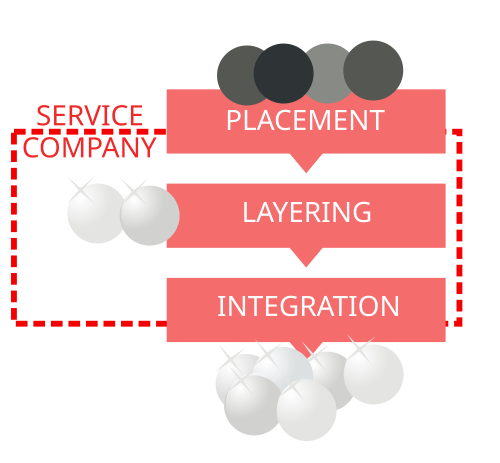Context: Certain experts have expressed concern with the increasingly technocratic nature of the Indian Welfare State where a rights-bearing citizen has been reduced to an auditable beneficiary or merely a data entry, thereby calling for a critical evaluation of the emerging digital welfare state of India.
PYQ:
1. Electronic cash transfer system for the welfare schemes is an ambitious project to minimize corruption, eliminate wastage and facilitate reforms. Comment. (2013) GS2
2. Besides the welfare schemes, India needs deft management of inflation and unemployment to serve the poor and the underprivileged sections of society. Discuss. (2022) GS2
Why a Welfare State?
- Vision of Constitution of India :
- The Preamble to the Constitution sets the stage by declaring India a “Sovereign, Socialist, Secular, Democratic Republic.” The Preamble also promises to secure for all citizens:
- Justice: Social, economic, and political.
- Equality: Of status and opportunity.
- These promises lay the foundational principles for a state that actively works to reduce disparities and ensure the well-being of all its people.
- The Directive Principles of State Policy : Articles 38 and 39
- Fundamental Rights : While the DPSP provides the positive obligations of the state, certain Fundamental Rights (Part III) also contribute to the vision of a welfare state by ensuring equality under Right to Equality and protecting against exploitation. Moreover, the ever widening scope of Article 21 requires the state to see freedom as capability development.
- Economic Imperative : Despite its rapid economic expansion, a significant portion of India’s population still lives in poverty. According to the National Multidimensional Poverty Index (MPI) Progress Review 2023, based on data from the National Family Health Survey (NFHS)-5 (2019-21), 14.96% of India’s population is still “multidimensionally poor.”A welfare state is thus, essential to provide a baseline of economic security.
- Social Imperative : Historical and social hierarchies have created deep-seated inequalities based on caste, class, religion, gender and so on. A welfare state aims to correct these imbalances and provide a path for upward mobility for all.
- Post LPG scenario : The LPG reforms have undeniably accelerated growth and modernized India’s economy, but they have also entrenched income, wealth, and regional inequalities. Recent Oxfam data highlight that the richest 1% in India control more than 40% of total wealth, while the bottom 50% own only about 3%. It highlights the need for calibrated welfare and redistributive policies to foster more inclusive growth.
India’s need for a welfare state is not merely an ideological choice but a practical necessity born from its vast population, historical inequalities, and ongoing development challenges. While a free-market economy is a powerful engine for growth, it can also exacerbate disparities. A welfare state, therefore, acts as a crucial safety net, a tool for social justice, and a catalyst for inclusive growth.
Present shape of welfare state
- Shift to Targeted and Rights-Based Approach: The economic liberalization of the 1990s led to a shift away from a universal, state-controlled model. The focus moved to targeted programs aimed at specific beneficiary groups. This was further solidified by a “rights-based” legislative framework in the early 2000s, which made social welfare a legal guarantee.
- Legislation has been passed to make welfare a legal entitlement, empowering citizens to demand their rights. This includes laws like the National Food Security Act (NFSA), MGNREGA and the Right to Education (RTE) Act.
- Technology as an Enabler: The most prominent development in recent years has been the integration of technology to improve the delivery of welfare services. The JAM (Jan Dhan-Aadhaar-Mobile) trinity has been instrumental in enabling Direct Benefit Transfers (DBT), aiming to reduce corruption and ensure that funds reach the intended beneficiaries directly. Examples:
- PM-KISAN: Under the Pradhan Mantri Kisan Samman Nidhi, farmers receive a financial assistance of ₹6,000 per year directly in their bank account, eliminating the need for a physical process and ensuring that only eligible farmers receive the benefit.
- MGNREGA Wages: Wages for workers under the Mahatma Gandhi National Rural Employment Guarantee Act are now directly credited to their bank accounts.
- e-Shram Portal: This portal was created to build a national database of unorganized workers in India.
- GIS for Scheme Implementation: GIS mapping is being used to identify underserved areas and to track the implementation of schemes like the Pradhan Mantri Awas Yojana (PMAY) for housing.
- Inadequate allocation of resources : The dedication to deliver welfare as shown in the increasing pace of digitisation is not matched by adequate allocation of resources for the same.
- The authors also express concern about the decline in India’s social sector spending that has dwindled to 17% in 2024-25 from the 2014-24 average of 21%. Further, there are some interesting observations beyond plain statistics.
- Key social sector schemes have borne the brunt of such decline where minorities, labour, employment, nutrition and social security welfare saw a significant decline from 11% (in the pre-COVID-19 phase) to 3% (in post-COVID-19 phase).
Benefits of digital welfarism
- Enhanced Transparency and Accountability: Digital systems create a verifiable trail for every transaction, making it difficult for corruption to thrive. This reduces the role of middlemen and ensures that public funds are used for their intended purpose. For instance, the Geographic Information System (GIS) is used to track the progress of physical projects, like the construction of houses under the Pradhan Mantri Awas Yojana (PMAY).
- Reduced Leakage and Corruption: By directly transferring funds to the beneficiaries’ bank accounts, the digital model eliminates the possibility of siphoning off funds. This has resulted in substantial savings for the government. The Direct Benefit Transfer (DBT) system has saved the government billions of rupees by preventing the diversion of funds in various schemes, including the Public Distribution System (PDS) and LPG subsidies(PAHAL) scheme.
- Improved Efficiency and Timely Delivery: Digital platforms automate processes that were previously manual and time-consuming. This speeds up the delivery of services and benefits, ensuring that citizens receive assistance when they need it most.
- Financial Inclusion: The push for digital welfare schemes, particularly through the Jan Dhan Yojana, has encouraged millions of unbanked citizens to open bank accounts. This has brought a large segment of the population into the formal financial system, empowering them with greater financial control.
- Empowerment of Citizens: Digital platforms provide citizens with direct access to information about government schemes, eligibility criteria, and the status of their applications. This reduces their dependency on local officials and empowers them to demand their rights. Platforms like myScheme help citizens discover the schemes they are eligible for, while the UMANG app provides a single interface for accessing a vast number of government services.
- Data-Driven Policy Making: Digital systems generate vast amounts of data that the government can use to analyze the effectiveness of its schemes. This allows for evidence-based policy making, helping the government to identify gaps and target resources more effectively.
Challenges underlying digital welfarism – highlighted by the author
- With a billion Aadhaar enrollments, 1,206 schemes integrated into the Direct Benefit Transfer system, and 36 grievance portals across States/Union Territories, India’s welfare orientation is transitioning into a technocratic calculus.
- Lack of democratic deliberations and participatory planning with the target group due to the unidirectional nature of schemes like E- SHRAM and PM- KISAN where the citizens have just become a passive receiver or beneficiary and not a right bearing citizen anymore what author has compared with homo sacer- a life stripped of political agency.
- Reduced scope of flexibility and situated knowledge that are very specific to the local contexts, say at gram Sabha level and frontline bureaucratic discretion. For example , the technological barriers and lack of digital literacy as being seen in recent problems faced due to compulsory biometric attendance in MGNREGA stripping the innocent labourers of their due. Moreover the travel to banks and ATMs to draw cash remain unaccounted for.
- Obsession with numbers instead of substance and outcomes – visibility of need and suffering depends on computability now. This concern is further highlighted in Justice D.Y Chandrachuď’s Aadhaar dissent (2018), that warned precisely against such decontextualisation of identity which served as a caution against reducing citizens to disembedded, machinic data who are devoid of care, context, or even constitutional assurance in some cases.
- Instead of accountability and transparency, the present state of affairs show crisis of accountability with a centralized public grievance redress and monitoring system flattening the federal hierarchies and making political accountability elusive as the focus remains merely on resolving tickets and complaints and their substance is reduced to a ticket number.
- The existential crisis of RTI aggravates this lack of accountability and responsibility. As of June 30, 2024, the number of pending cases crossed the four lakh tally across 29 Information Commission’s (ICs), and eight CIC posts were vacant (annual report of CIC, 2023-24).
- The promise to deliver social welfare at scale, bypassing leaky pipelines and eliminating ghost beneficiaries, might have actually led to a ‘re-casting’ that delivers ‘efficiency’ and ‘coverage’ at the cost of ‘democratic norms’ and ‘political accountability’.
Way Ahead
Authors’ suggestions:
- Thinking along the lines of ‘democratic antifragility’ so that our systems built on perfect data and flawless infrastructure do not fail catastrophically under stress.
- We need to empower States to design context-sensitive regimes where federalism and welfare push for pluralism as a feature.
- Institutionalising community-driven impact audits (as reiterated by the UN Special Rapporteur on Extreme Poverty), by looping in the Rashtriya Gram Swaraj Abhiyan and Gram Panchayat Development Plans should be the core target.
- All States must be made capable to build platform cooperatives where self-help groups act as intermediaries; functionally, lessons can be learnt from Kerala’s Kudumbashree.
- Civil society must be incentivised to invest in grass-roots political education and legal aid clinics in order to strengthen the community accountability mechanisms.
- Lastly, it is time we strengthen and codify our offline fall-back mechanisms, human feedback safeguards, and statutory bias audits by embedding the “right to explanation and appeal” as proposed by the UN Human Rights for digital governance systems.
Digital governance brings numerous benefits with it undoubtedly but we must realise that a welfare state stripped of democratic deliberations is a machine that works efficiently for everyone except those it is meant to help. For a Viksit Bharat we will have to reorient digitisation with democratic and anti-fragile principles so that citizens become partners in governance, and not mere entries in a ledger.






